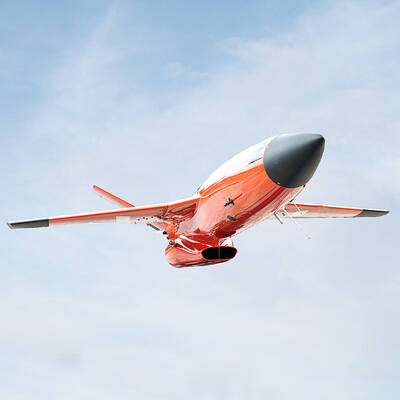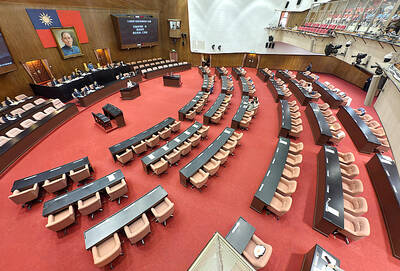The London Organising Committee of the Olympic and Paralympic Games (LOCOG) has allowed spectators to show small-sized Republic of China (ROC) national flags in venues of the Olympic Games, a Ministry of Foreign Affairs official said yesterday.
Hsu Mien-sheng (徐勉生), the director-general of the ministry’s Department of European Affairs, described the move as a “gesture of goodwill” extended to Taiwan after an ROC flag was removed from an array of 206 national colors, representing the nations competing in the Olympic Games, in a London street. The display was organized by the Regent Street Association.
The Taipei Representative Office in the UK had reached an understanding with the LOCOG that Olympic-venue security staff would allow spectators to dress in the colors of the ROC flag, paint the ROC flag on their faces, or bring small ROC flags with them to the venues, Hsu said.

Photo: courtesy of Chen Szu-wei
Hsu said that the display of the ROC flag in seating areas is not in compliance with the protocol signed between Taiwan and the International Olympic Committee (IOC) in 1981, known as the “Olympic Model,” to resolve issues stemming from a sovereignty dispute with China.
In accordance with the protocol, Taiwan competes in the Olympics under the name “Chinese Taipei” and is represented by the Chinese Taipei Olympic flag at Olympic venues, rather than the ROC flag.
“Strictly speaking, only the Chinese Taipei Olympic flag recognized by the IOC is allowed in Olympic venues, including its audience areas,” Hsu said.
According to a Central News Agency report, large ROC flags are still forbidden until changes are made to the model. Hsu did not verify that report, but he said the Olympics organizers do not allow spectators of any nationality to wave large national flags of any country, to keep them from disturbing other people in the audience.
The Chinese-language Liberty Times (the Taipei Times’ sister paper) reported that some Taiwanese spectators were warned by Olympics staff for waving large ROC flags to cheer on the country’s taekwondo athletes, Yang Shu-chun (楊淑君) and Wei Chen-yang (魏辰洋), during Wednesday’s matches.
A woman surnamed Chen (陳) told the Liberty Times that Olympics staff asked them not to wave the flag and even tried to grab their flag. She added that they were kept under close watch by staff members until they left.
Hsu said he was not able to verify the report.
He added that the nation’s representative office has on several occasions expressed concerns to the Regent Street Association over its replacing the ROC flag with a Chinese Taipei Olympic flag.
The LOCOG has confirmed that it advised the association to remove the ROC flag after a complaint from the Chinese embassy.
The association made it clear to the representative office that it “meant no disrespect” to Taiwan and felt sorry for any offense caused, Hsu said.
The association was “overloaded” with telephone complaints and e-mails from UK politicians, ordinary British citizens and people from other countries about the replacement of the ROC flag in the display, Hsu said.
Some members of the UK parliament also sent letters to the association to express their disapproval and demand a remedy, Hsu added.

CROSS-STRAIT COLLABORATION: The new KMT chairwoman expressed interest in meeting the Chinese president from the start, but she’ll have to pay to get in Beijing allegedly agreed to let Chinese Nationalist Party (KMT) Chairwoman Cheng Li-wun (鄭麗文) meet with Chinese President Xi Jinping (習近平) around the Lunar New Year holiday next year on three conditions, including that the KMT block Taiwan’s arms purchases, a source said yesterday. Cheng has expressed interest in meeting Xi since she won the KMT’s chairmanship election in October. A source, speaking on condition of anonymity, said a consensus on a meeting was allegedly reached after two KMT vice chairmen visited China’s Taiwan Affairs Office Director Song Tao (宋濤) in China last month. Beijing allegedly gave the KMT three conditions it had to

‘BALANCE OF POWER’: Hegseth said that the US did not want to ‘strangle’ China, but to ensure that none of Washington’s allies would be vulnerable to military aggression Washington has no intention of changing the “status quo” in the Taiwan Strait, US Secretary of Defense Pete Hegseth said on Saturday, adding that one of the US military’s main priorities is to deter China “through strength, not through confrontation.” Speaking at the annual Reagan National Defense Forum in Simi Valley, California, Hegseth outlined the US Department of Defense’s priorities under US President Donald Trump. “First, defending the US homeland and our hemisphere. Second, deterring China through strength, not confrontation. Third, increased burden sharing for us, allies and partners. And fourth, supercharging the US defense industrial base,” he said. US-China relations under

The Chien Feng IV (勁蜂, Mighty Hornet) loitering munition is on track to enter flight tests next month in connection with potential adoption by Taiwanese and US armed forces, a government source said yesterday. The kamikaze drone, which boasts a range of 1,000km, debuted at the Taipei Aerospace and Defense Technology Exhibition in September, the official said on condition of anonymity. The Chungshan Institute of Science and Technology and US-based Kratos Defense jointly developed the platform by leveraging the engine and airframe of the latter’s MQM-178 Firejet target drone, they said. The uncrewed aerial vehicle is designed to utilize an artificial intelligence computer

The Chinese Nationalist Party (KMT) caucus yesterday decided to shelve proposed legislation that would give elected officials full control over their stipends, saying it would wait for a consensus to be reached before acting. KMT Legislator Chen Yu-jen (陳玉珍) last week proposed amendments to the Organic Act of the Legislative Yuan (立法院組織法) and the Regulations on Allowances for Elected Representatives and Subsidies for Village Chiefs (地方民意代表費用支給及村里長事務補助費補助條例), which would give legislators and councilors the freedom to use their allowances without providing invoices for reimbursement. The proposal immediately drew criticism, amid reports that several legislators face possible charges of embezzling fees intended to pay